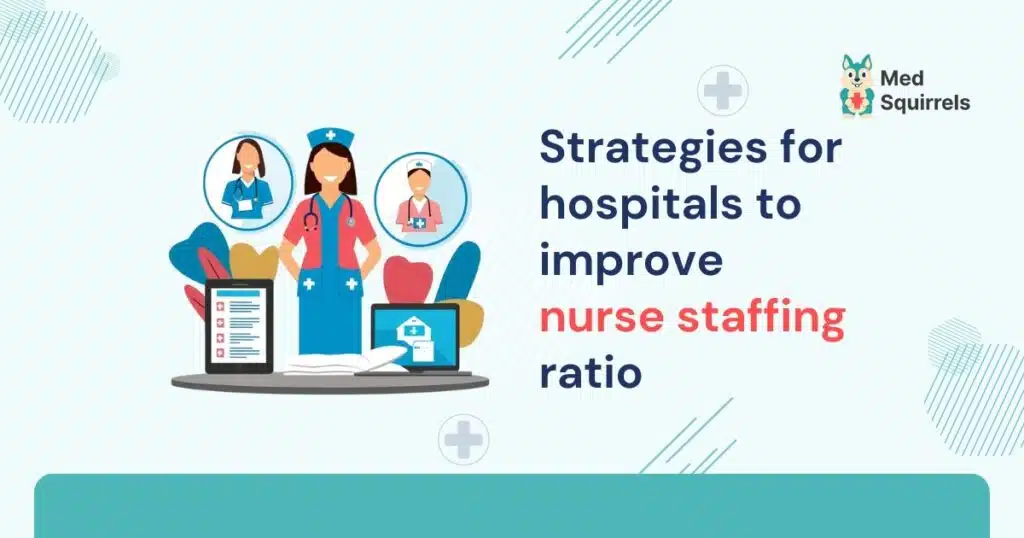Strategies for hospitals to improve nurse staffing ratio

According to the latest survey, it is revealed that hospitals with adequate nurse staffing have played a significant part in improving patient outcomes. It is a well-known fact that hospitals with enough nurses on the floor can deliver good patient outcomes. A good ratio of nurses to patients and effective healthcare staff ratios will create a better environment by avoiding medical errors and complications, reducing the mortality rate, avoiding hospital-acquired infections (HAIs), and also boosting patient satisfaction.
However, it is a challenge to keep enough nurses on the floor and maintain a positive ratio between nurses and patients. Most facilities are said to be facing difficulty in hiring candidates who fit the role. On the other hand, the demand for nurses is skyrocketing now. In the face of these issues, hospitals are experiencing low patient outcomes due to a negative ratio of nurses to patients, underscoring the importance of smart nurse staffing.
In this blog, we will discuss effective strategies that hospitals can employ to improve the nurse staffing ratio.
Introduce data-driven staffing models It is a complex task to track and analyze the smart nurse staffing ratio by considering patient outcomes. However, with data-driven staffing tools, facilities tend to understand the reports quickly and implement acuity-based staffing models that match patient care and needs.
Facilities need not worry about working round the clock on creating reports and analyzing. With the analytics provided by the tools, one can make the quick and right decisions about staffing. Not only that, but we can also keep a regular track of staffing levels, thereby adjusting the workforce levels by focusing on smart nurse staffing analytics.
Create flexible work arrangements
It is important to manage the staff by creating more flexible work schedules. Facilities must understand the need to create flexible work schedules for the workforce in order to maintain a positive nurse staffing ratio and improve nurse-to-patient ratios.
Hospitals experienced a significant number of resignations from nurses in 2023 because of nurse burnout issues. As the workload increases, nurses face issues in delivering the desired care and compassion to the patients as the nurse-to-patient ratio is mismatched. It is crucial to realize that flexible staffing solutions play a key role in balancing the nurse staffing ratio, and this also promotes mental health for nurses.
Travel nurses, per diem staff, and on-call nurses are having a positive impact on maintaining patient outcomes. At times, facilities may face fluctuations in patient volumes or nurse absences due to illness or other unforeseen situations. In these scenarios, these flexible solutions act as a backup to keep up the nurse staffing ratios and ensure healthcare staff ratios. Not only that, facilities can also have access to specialized skills and can cut down costs by following flexible nurse staffing solutions.
Recruit as well as retain nurses
Recruitment and retention are crucial strategies for the facilities to balance the nurse staffing ratio. To maintain a balance between the nurse and patient levels, it is necessary to hire and retain optimal nurses based on the patient count. As per the hospital association policies, facilities must ensure optimal nurses are on the floor, matching the patient count.
Facilities must develop a strong employer reputation to attract more talent. It is a good practice to analyze the recruiting market in order to know how much to pay for a provider. Competitive salaries, compensations, and benefits attract top talent. The top talent will further leverage the hospital’s reputation by playing a crucial role in nurse staffing ratios and patient outcomes.
However, building a strong workforce requires proper recruiting approaches and smart nurse retention strategies. Hiring a new provider for the role and releasing the old provider would create additional operations, such as training the provider and educating him about the job functions and operations. This would be hectic. Retaining the provider is a smart move that contributes to how to improve nurse-to-patient ratios through consistent and experienced staffing.
Integrate facilities with technologies
It is evident that the latest technologies are making prominent changes in the healthcare department. Tasks like patient registration and intake, preparing reports and summaries, monitoring the patient’s medical condition, and many other minimal tasks can be handled by the latest AI technologies.
In healthcare facilities following traditional technologies and norms, nurses are found to spend additional time on day-to-day minimal tasks that can be easily handled by AI tools. This would further create clutter in patient monitoring and nurse staffing ratios and patient outcomes. Also, these minimal interventions create burnout for nurses and do not allow them to focus on important tasks completely. This gap is acting as a crucial point in resignations.
By integrating your facility with these technologies, you will free up a lot of time for nurses to focus more on complex tasks and patient outcomes. But how will integrating technologies into your facilities help maintain a positive nurse staffing ratio?
With these technologies playing their part, it will reduce burnout rates for nurses as the minimal tasks will be taken care of by the AI. These implementations would create healthy impressions for nurses as well as time to focus more on important tasks and to relieve themselves for a while. This is how smart nurse staffing and integrating technologies can contribute to nurse staffing ratios and patient outcomes.
Empower nurses with fair work policies and benefits
The facilities that address the nurse issues by fostering fair work policies tend to maintain a positive nurse staffing ratio. Facilities must ensure dedicated policies for the nurses, such as performance-based incentives, health and wellness programs, childcare assistance, stress management programs, and career development opportunities. Such policies integrate a positive note on facilities, playing a key role in maintaining the nurse staffing ratio.
Proper nurse staffing requires regular monitoring of the workforce and patient outcomes. It also requires continuous monitoring of the new strategies for adapting. This process creates a thriving healthcare environment where nurses and patients can prosper. By focusing on how to improve nurse-to-patient ratios and incorporating healthcare staff ratios into their policies, facilities can better manage their staffing needs and enhance overall care quality.
Conclusion
Balancing the nurse staffing ratio to patient count is a complex challenge, but it can be achieved by following the smart strategies discussed above. By implementing smart data-driven staffing models, creating flexible staffing solutions, incorporating proper recruitment and retention strategies, and promoting healthy nurse policies can assist healthcare facilities to maintain a positive nurse staffing ratio that fosters good patient outcomes and enhances the employer brand. These are all effective ways of how to improve nurse-to-patient ratios.
MedSquirrels can help achieve the path to more balanced nurse staffing. MedSquirrels is one of the top-performing healthcare platforms engaged in the acquisition of top talent across the US. MedSquirrels holds a large portfolio of clinicians, non-clinicians, allied healthcare staff, travel nurses, registered nurses, and CNAs. These professionals can positively impact healthcare staff ratios nurse staffing ratios, and patient outcomes.
Are you still worried about recruitment operations? Let us take the challenge! At MedSquirrels, we take care of the entire hiring process, including screening, interviewing, assessing, and onboarding the candidate quickly and efficiently.
Need help with payrolling? MedSquirrels has been established as a leading payroll provider. We take care of payroll by assuring on-time payments without a single-day delay by providing efficient and transparent billing. As an employer of record, we handle financial and benefits management with zero compliance risks to you. Our smart nurse staffing solutions are designed to streamline operations and improve nurse-to-patient ratios effectively.
FAQs
Why is the improvement of nurse staffing ratios crucial for hospitals?
Improvement of nurse staffing ratios is crucial because proper staffing corresponds to better outcomes for patients, less medical errors, and greater patient satisfaction rates. Proper nurse-to-patient ratios in the hospital reduce mortality rates and minimize complications, thereby serving the patient better.
How can hospitals address the challenges of fluctuating patient demands in terms of nurse staffing?
The use of smart nurse staffing models such as predictive analytics can help manage fluctuating patient needs by forecasting when patients will be admitted and therefore adjusts the available staffing accordingly. Also, allowing nurses to work full-time, part-time, and per diem flexibilities can also support client need care. The management of variability in patient demand can be helped with the use of float pools, and the cross-training of nurses ensures that the level of staff is adequate to allow for good maintenance in taking care of patients.
What role does technology play in improving nurse staffing ratios and patient outcomes?
Technology plays a crucial role in the improvement of nurse staffing ratios and improved patient outcomes by streamlining administrative tasks, enhancing communication, and always providing data for better decisions in near-real time. EHRs, staffing software, telehealth services will help free up time for the nurses to attend to patients and thereby improve nurse staffing ratio and patient outcome.
How can hospitals improve nurse-to-patient ratios without compromising care quality?
Enhancing nurse-to-patient ratios should be multidimensional, with strategies like hiring more nurses, reducing staff turnover, employing technology to make their workflows more efficient, and even involving nursing staff in ongoing training and professional development programs that ensure not only good skills and knowledge but excellent service delivery.
What strategies can hospitals implement for nurse well-being to reduce nurse staffing ratios?
Hospitals can also promote well-being in nurses with programs on mental health and stress management, counseling services available to every employee, and a healthy balance between work and life. Indeed, rewards, like wellness programs, continuing education, and recognition awards, can also impact job satisfaction and keep more nurses in service. The good thing about this is that nurse well-being both improves nurse staffing ratios and patient outcomes.
